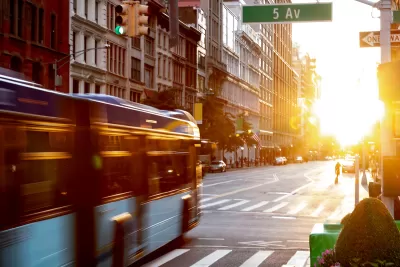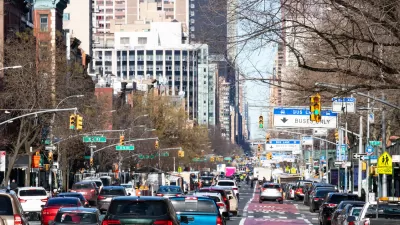Sharing lanes with car traffic may make it impossible for the MTA to increase service frequency.

Bus frequency in New York City is hindered by congestion, writes Dave Colon in Streetsblog NYC, making it practically impossible for the Metropolitan Transportation Authority (MTA) to meet a goal of improving frequency by 20 percent.
Buses will never beat a subway in terms of the total number of people one bus can move compared to a full subway train. But that doesn't mean buses need to provide significantly less bang for their buck, which is what happens when they're caught in a sea of double parked cars and trucks parked in the bus lane.
One potential solution is ramping up the use of automated enforcement to cite drivers who block bus lanes. “ABLE [Automated Bus Lane Enforcement] cameras have improved bus speeds by 5 percent on routes where they're used, and faster buses are of course one way to get more bus service for less money, as the Citizens Budget Commission pointed out in a policy brief on MTA finances in the dark days of 2021.” Yet New York’s buses are moving at the same speed now as in 2018—7.5 miles per hour.
Redesigning inefficient bus routes could also help speed up service. “City bus stops are notoriously close together compared to international peers, which means buses are constantly stopping and starting. The buses also run on long and circuitous routes that haven't been updated in decades, forcing drivers to navigate tight streets and wait out traffic to make left turns.”
Meanwhile, “A spokesperson for the MTA did not dispute the tenor of the budget negotiations, but focused on the fact that the transit system survived at all.”
FULL STORY: City Traffic Helps Make Bus Service Unbearable, Expensive And Difficult To Improve

Maui's Vacation Rental Debate Turns Ugly
Verbal attacks, misinformation campaigns and fistfights plague a high-stakes debate to convert thousands of vacation rentals into long-term housing.

Planetizen Federal Action Tracker
A weekly monitor of how Trump’s orders and actions are impacting planners and planning in America.

Chicago’s Ghost Rails
Just beneath the surface of the modern city lie the remnants of its expansive early 20th-century streetcar system.

Bend, Oregon Zoning Reforms Prioritize Small-Scale Housing
The city altered its zoning code to allow multi-family housing and eliminated parking mandates citywide.

Amtrak Cutting Jobs, Funding to High-Speed Rail
The agency plans to cut 10 percent of its workforce and has confirmed it will not fund new high-speed rail projects.

LA Denies Basic Services to Unhoused Residents
The city has repeatedly failed to respond to requests for trash pickup at encampment sites, and eliminated a program that provided mobile showers and toilets.
Urban Design for Planners 1: Software Tools
This six-course series explores essential urban design concepts using open source software and equips planners with the tools they need to participate fully in the urban design process.
Planning for Universal Design
Learn the tools for implementing Universal Design in planning regulations.
planning NEXT
Appalachian Highlands Housing Partners
Mpact (founded as Rail~Volution)
City of Camden Redevelopment Agency
City of Astoria
City of Portland
City of Laramie





























